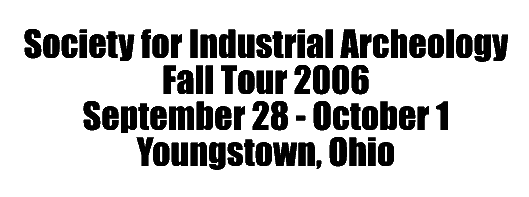
 |
| Welcome to the SIA 2006 Youngstown Fall Tour website. On this page you will find information about the city's history. Explore the rest of the site to see information about the tour, as well as the places we will visit. Note: This site is best viewed with a screen resolution of 800 x 600 pixels. |
|
| YOUNGSTOWN -----John Young, a land speculator and surveyor, established what would be called Youngstown in 1786. The community started as a small settlement on the banks of the Mahoning River. The iron industry came early to the Mahoning Valley with the establishment of the Hopewell Furnace in 1803 by brothers James and Daniel Heaton. They erected what is believed to be the first blast furnace west of the Alleghenies on the banks of Yellow Creek near what is now the city of Struthers. The first Heaton furnace went out of blast around 1812, but James Heaton continued in the iron industry, building another furnace in Niles in 1813, and later, along the banks of the Mill Creek in Youngstown. |
Historic View Looking West from Market Street Bridge. --- Courtesy of Jim Gallo |
|
Click above for a larger views of the postcard. Courtesy of Donna DeBlasio |
-----The iron industry really took off in the mid-nineteenth century with the discovery of local deposits of coal, iron ore and limestone, the three ingredients necessary for the production of pig iron. In fact, the local coal was so pure that it did not have to be coked before loading into the blast furnace. By the mid-1800s, the area had its first finishing mill – the Youngstown Mill Company. It was purchased by Brown, Bonnell Company and later on, in 1899, by Republic Iron and Steel Company. In 1907, Republic moved its headquarters from Pittsburgh to Youngstown. Founded in 1892 and later part of the Carnegie-Illinois Steel division of US Steel, the Ohio Steel Company poured the first Bessemer Process steel in the Valley in 1895. |
| Other steelmakers followed the company’s lead giving Youngstown and the Valley its primary industry and image. By the mid-1920s, there were three large fully integrated steel operations in Youngstown; besides Republic Iron and Steel Company and Carnegie-Illinois Steel, there was the Youngstown Sheet and Tube Company (YS&T) founded in 1901 in East Youngstown – the town was renamed in 1926 to honor James A. Campbell, the company’s longtime president. YS&T was the largest employer in the Mahoning Valley; in 1923, it bought out the locally owned Brier Hill Steel Company, giving the company two integrated facilities in the Mahoning Valley. In addition, Republic Steel had a second integrated steel mill in nearby Warren, which today operates as WCI Steel. At the end of World War I, US Steel constructed finishing mills further north of Youngstown in what is now the town of McDonald, built by the company to house its workers. |
|
McDonald Steel |
| -----All told, more than 20,000 people depended on the steel industry at its peak, for their livelihood. The tremendous growth of the steel industry in the early twentieth century also meant a concurrent growth in population. Immigrants came from southern and eastern Europe by the thousands seeking jobs in the steel mills. Around the time of World War I, with a decrease in immigration, mill owners went to the American South looking for employees, bringing many African-Americans to the area. The immigration and migration patterns contributed to the rich cultural diversity that is in the Mahoning Valley today. The huge labor force also meant that the area saw its share of labor struggles, including steel strikes in 1916, 1919, 1937, 1952, and 1959. |
-----With the closing of the mills beginning in 1977, the Mahoning Valley was thrown into an economic crisis. The iron and steel industry is a shadow of its former self with WCI Steel now its only integrated steel mill and small operations like mini mills at V&M Star Steel in Youngstown and McDonald Steel in McDonald a reminder of the area’s great industrial heritage.
|
WCI Steel Blast Furnace |